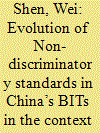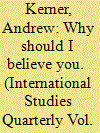| Srl | Item |
| 1 |
ID:
163441


|
|
|
|
|
| Summary/Abstract |
The European Union (EU) and the People’s Republic of China (PRC or China) in January 2014 decided to launch negotiations on a bilateral treaty addressing the promotion and protection of investment between the two parties. This article mainly examines the legal positions from which the parties will proceed their negotiations in terms of the non-discriminatory standards, that is, the national treatment and the most-favored-nation treatment, which are said to be the cornerstone of foreign investment protection, by focusing on the evolution of non-discriminatory standards in China’s BITs against the same standards in the EU BITs, in particular, the EU’s recently concluded three important treaties regulating, among other things, foreign investment, namely with Canada, Singapore and Vietnam. Domestically, the reference value of BITs signed by China in the 1980s and 1990s has been significantly affected by the dynamic economic reform and market development in the past four decades. Essentially, globalisation has fundamentally lifted China’s foreign investment standards up to international standards. As a result, while the market anticipates the difficulties in the ongoing negotiations, the gap between the EU and China, as argued in this article, should be noticeably slight when the EU and China come to negotiate the non-discriminatory standards.
|
|
|
|
|
|
|
|
|
|
|
|
|
|
|
|
| 2 |
ID:
087574


|
|
|
|
|
| Publication |
2009.
|
| Summary/Abstract |
Bilateral Investment Treaties (BITs) are the primary legal mechanism protecting foreign direct investment (FDI) around the world. BITs are thought to encourage FDI by establishing a broad set of investor's rights and by allowing investors to sue a host state in an international tribunal if these rights are violated. Perhaps surprisingly, the empirical literature connecting BITs to FDI flows has produced conflicting results. Some papers have found that BITs attract FDI, while others have found no relationship or even that BITs repel FDI. I suggest in this paper that these results stem from statistical models that do not fully capture the causal mechanisms that link BITs to FDI. Extant literature has often suggested that BITs may encourage investment from both protected and unprotected investors, yet the literature has not allowed for a full evaluation of this claim. This paper explores the theoretical underpinnings and empirical implications of an institution that works in these direct and indirect ways, and offers a statistical test that is capable of distinguishing between the two. The results indicate that: (1) BITs attract significant amounts of investment; (2) BITs attract this investment from protected and unprotected investors; and (3) these results are obscured by endogeneity unless corrected for in the statistical model.
|
|
|
|
|
|
|
|
|
|
|
|
|
|
|
|